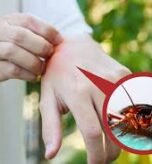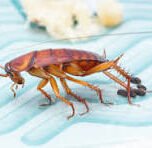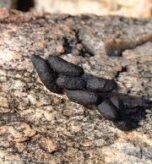Cockroaches are highly resilient pests that pose a significant challenge to homeowners and businesses. Their presence is more than just a nuisance; they are known carriers of various pathogens and allergens that can trigger asthma attacks. If you want to get rid of cockroaches, you need a comprehensive approach that combines identification, understanding the risks, and implementing effective management strategies.
The Dangers of a Cockroach Infestation
Cockroaches are more than just an unpleasant sight; the World Health Organization (WHO) classifies them as “unhygienic scavengers.”
The Health Risks of Cockroaches
While direct links to specific disease outbreaks are limited, cockroaches are known to carry harmful bacteria. If they deposit these bacteria on your food or kitchen surfaces, it can lead to illnesses like salmonella, staphylococcus, and streptococcus. Furthermore, they can scratch you with their heavy leg spines, and these scratches could become infected.
The Allergy and Asthma Connection
Cockroaches are a major source of indoor allergens. Enzymes found in their droppings, shed body parts, and saliva can cause allergic reactions in many people. Symptoms often include wheezing, coughing, skin rashes, and nasal congestion. For people with asthma, especially children, prolonged exposure can lead to a severe worsening of symptoms.
How to Identify a Cockroach Infestation
Early detection is crucial if you want to get rid of cockroaches effectively. Since these pests are nocturnal, their droppings and other signs are vital clues.
Visual Clues: Droppings and Egg Casings
Cockroach droppings vary in appearance depending on the species.
- Small species, like the German cockroach, produce droppings that look like tiny black specks or coffee grounds.
- Large species, like the American cockroach, leave behind dark, cylindrical pellets with distinct ridges.
Besides droppings, finding their brownish, oval-shaped egg casings (oothecae) is a clear sign of a breeding population.
Other Telltale Signs of an Infestation
- A Distinct Musty Odor: A strong, oily, or musty smell can signal a large cockroach infestation.
- Frequent Sightings: Seeing live roaches, especially during the day, often means you have a significant, hidden colony.
- Grease Marks: Cockroaches leave oily smears along their regular pathways on walls and floors.
- Chewed Food Packaging: Small holes or chewed edges on food packaging are another common sign.
How to Get Rid of Cockroaches: DIY Home Remedies
For minor infestations, several home remedies can help deter or eliminate cockroaches.
Natural Roach Repellents
- Bay Leaves: Their strong scent naturally repels roaches.
- White Vinegar: A mixture of equal parts water and vinegar sprayed in affected areas can deter them.
- Mint Oil: A spray of mint oil and water can create a natural barrier.
- Lemon Juice: The citric acid in lemon juice repels roaches.
- Cedar: The strong smell of cedarwood naturally deters them.
DIY Killers and Traps
- Boric Acid: Dust a small amount in corners and along floors. It is deadly to roaches but must be used with caution as it is dangerous for children and pets.
- Baking Soda and Sugar Trap: Mix equal parts and sprinkle in infested areas. The sugar attracts them, and the baking soda is lethal upon ingestion.
- Diatomaceous Earth (DE): This natural powder has sharp microscopic particles that cut the cockroach’s exoskeleton, causing it to dehydrate and die.
- Soap and Water Spray: When sprayed directly on a roach, a simple soap and water solution can block its breathing pores and suffocate it.
Best Practices for Preventing Cockroaches
Long-term prevention is the most critical step to get rid of cockroaches for good.
- Seal All Entry Points: Close any cracks, gaps, and holes around your doors, windows, and plumbing.
- Eliminate Their Food Sources: Store all food, including pet food, in airtight containers. Clean up crumbs and spills immediately.
- Reduce Moisture: Fix any leaky pipes and use dehumidifiers in damp areas like basements.
- Declutter Your Home: Remove cardboard boxes, old newspapers, and other clutter that provides hiding spots.
- Inspect Items Entering Your Home: Carefully check storage boxes, packages, and groceries before bringing them inside.
When to Call a Professional to Get Rid of Cockroaches
While DIY remedies can offer temporary relief, a severe or persistent infestation often requires professional help. You should call an expert if you notice:
- Frequent sightings of live or dead cockroaches.
- A foul, persistent musty odor.
- The presence of egg casings.
- Cockroach droppings in multiple locations.
Professional pest control services use targeted gel baiting and odorless sprays to reach hidden colonies that DIY methods often miss. They can break the breeding cycle and offer long-term, warranty-backed protection.
How to Safely Clean Up Cockroach Droppings
Cleaning up droppings is essential for hygiene and because the feces contain pheromones that attract more roaches.
- Wear Protective Gear: Always wear gloves and a mask to prevent direct contact with and inhalation of allergens.
- Vacuum or Sweep: Use a vacuum with a HEPA filter to collect dry droppings.
- Disinfect Surfaces: Wipe down all affected areas with a strong disinfectant or a bleach solution.
- Dispose of Waste Properly: Seal all collected droppings and used cleaning materials in a plastic bag before disposing of them.
Conclusion
To successfully get rid of cockroaches, you need a multi-faceted approach. Their presence poses a serious health risk, and a proactive strategy that includes rigorous sanitation, proper food storage, and moisture control is your best defense. If an infestation persists, contacting a professional pest control service is the most effective step toward achieving a long-lasting, pest-free living environment.




